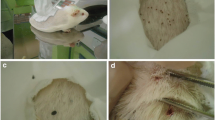Conclusions
In conclusion it may be said that while the laboratory investigations on the virus or viruses of sandfly fever, which were encountered in the Mediterranean area and in the Middle East, gave us a good deal more information on the basic properties of the virus and, also, provided a supply for storage and future studies, the primary objectives of developing some method of propagating the virus outside of the human body and of a vaccine for the protection of exposed personnel, were not attained. It is, therefore, particularly fortunate that DDT was found to be so highly effective for the control ofPhlebotomus papatasi in dwellings22, and that the available mosquito repellents proved so effective in protecting those who may be exposed out of doors. Even if future efforts should not lead to the discovery of a vaccine, sandfly fever need no longer be the military problem that it had been in various operations in endemic areas in the past.
Similar content being viewed by others
References
Doerr, R., K. Franz andS. Taussig: Das Pappatacifieber, Leipzig: F. Deuticke.1909
Doerr, R. andV. K. Russ: Weitere Untersuchungen über das Pappatacifieber. Arch. Schiffs- u. Tropenhyg.13, 693 (1909).
Birt, C.: Phlebotomus Fever in Malta and Crete. J. Roy. Army med. Corps14, 236 (1910).
Tedeschi, A. andM. Napolitani: Experimentelle Untersuchungen über die Aetiologie des „Sommerfiebers“. Zbl. Bakter. (Abt. 1)57, 208 (1911).
Shortt, H. E., L. T. Poole, andE. D. Stephens: Note on Some Experiments with Sandfly Fever Blood and Serum. Indian J. med. Res.23, 279 (1935).
Moshkovsky, S. D. and others: Pappataci Fever. Med. Parasitol. (Moscow)5, 823 (1936).
Shortt, H. E., L. T. Poole, andE. D. Stephens: Sandfly Fever on the Indian Frontier: A Preliminary Note on Some Laboratory Investigations. J. Roy. Army med. Corps63, 361 (1934);64, 17 (1935).
Shortt, H. E., R. S. Rao, andC. S. Swaminath: Cultivation of the Viruses of Sandlfy Fever and Dengue Fever on the Chorioanalltoic Membrane of the Chick Embryo. Indian J. med. Res.23, 865 (1936).
Shortt, H. E., C. G. Pandit, andR. S. Raó: The Virus of Sandfly Fever in Culture and Certain of Its Properties. Indian J. med. Res.26, 229 (1938).
Shortt, H. E., C. G. Pandit, andW. M. E. Anderson: Studies on Sandfly Fever. Abstracts of Communications, Third International Congress for Microbiology,1939, p. 133.
Demina, N. A. andP. B. Levitanskaya: Studies on Pappataci Fever: X. Attempts to Cultivate the Virus on the Chorioallantois of Chick Embryo. Med. Parasitol. (Moscow)9, 272 (1940); abstr., Trop. Dis. Bull.40, 305 (1943).
Demina, N. A.: Studies on Pappataci Fever: XI. Further Investigations on the Pappataci Virus in Culture. Med. Parasitol. (Moscow),10, 271 (1941); abstr., Trop. Dis. Bull.,40, 305 (1943).
Moshkovsky, S. D., N. A. Demina, and others: Studies on Pappataci Fever: VIII. On the Presence of the Virus in Phlebotomi Born from Eggs Laid by Infected Females. Med. Parasitol. (Moscow)8, 922 (1937).
Walker, A. S. andL. Dods: Clinical Impressions of an Epidemic of Sandfly Fever in Palestine during 1940. Med. J. Austral.1, 345 (1941).
Cullinan, E. R. andS. R. F. Whittaker: Outbreak of Sandfly Fever in Two General Hospitals in the Middle East. Brit. med. J. (Oct. 30)543 (1943).
Sabin, A. B., C. B. Philip, andJ. R. Paul: Phlebotomus (Pappataci or Sandfly) Fever: A Disease of Military Importance; Summary of Existing Knowledge and Preliminary Report of Original Investigations. J. Amer. med. Assoc.125, 603–606, 693–699 (1944).
Philip, C. B., J. R. Paul, andA. B. Sabin: Dimethyl Phthalate as a Repellent in Control of Phlebotomus (Pappataci or Sandfly) Fever. War Med.6, 27 (1944).
Paul, J. R., W. P. Havens, Jr.,A. B. Sabin, andC. B. Philip: Transmission Experiments in Serum Jaundice and Infectious Hepatitis. J. Amer. med. Assoc.128, 911 (1945).
Whittingham, H. E.: The Etiology of Phlebotomus Fever. J. State Med.32, 461 (1924).
Van Rooyen, C. E. andA. J. Rhodes: Virus Diseases of Man. p. 516. London: Oxford University Press.1940
Sabin, A. B.: The Dengue Group of Viruses and Its Family Relationships. Bacter. Rev.14, 225 (1950).
Hertig, M. andR. A. Fisher: Control of Sandflies with DDT. Bull. U. S. Army med. Dept., No. 88 (May) 97 (1945).
Author information
Authors and Affiliations
Additional information
The work reported in this communication was carried out with the aid and under the auspices of the Commission on Neurotropic Viruses, Board for the Investigation and Control of Influenza and Other Epidemic Diseases in the Army, Preventive Medicine Division, Office of The Surgeon General, United States Army. The author was on activé duty consecutively as Major and Lieutenant Colonel in the Medical Corps of the Army. The work was begun early in 1943, near the Dead Sea in Palestine, and then continued consecutively in the Commission's Laboratory in a U. S. Army Hospital outside Cairo, Egypt, at the Children's Hospital Research Foundation and the Longview State Hospital, Cincinnati, Ohio, and finally at the Rockefeller Institute at Princeton, New Jersey and at the New Jersey State Prison at Trenton.
This article was prepared as part of the medical history program of the Army, and, with certain minor modifications, will appear in the forthcoming “History of Preventive Medicine, U. S. Army Medical Department, World War II”. It is an honor and privilege to have this article published in a volume dedicated to ProfessorR. Doerr, whose classic studies revealed the most important information currently available on pappataci fever.
Rights and permissions
About this article
Cite this article
Sabin, A.B. Experimental studies on phlebotomus (pappataci, sandfly) fever during world war II. Archiv f Virusforschung 4, 367–410 (1951). https://doi.org/10.1007/BF01241161
Issue Date:
DOI: https://doi.org/10.1007/BF01241161




